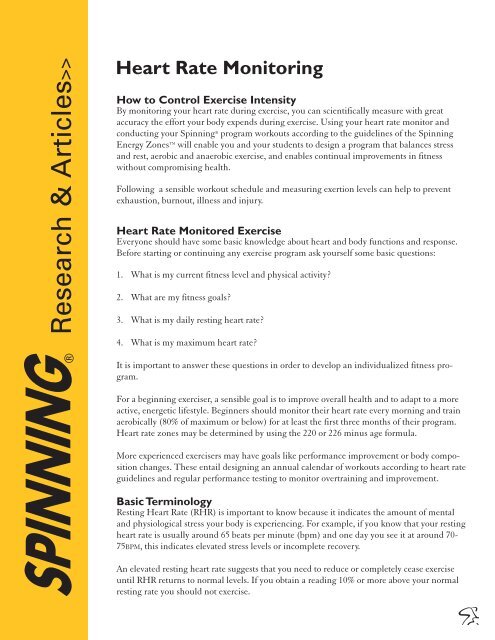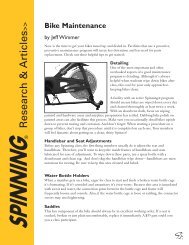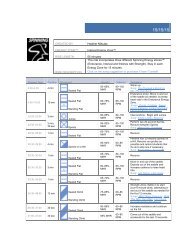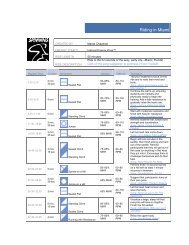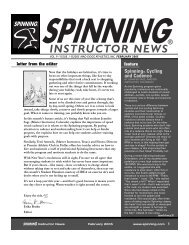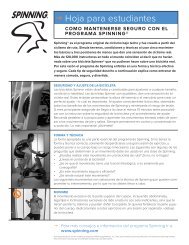Heart Rate Monitoring - Spinning
Heart Rate Monitoring - Spinning
Heart Rate Monitoring - Spinning
You also want an ePaper? Increase the reach of your titles
YUMPU automatically turns print PDFs into web optimized ePapers that Google loves.
Research & Articles>><br />
<strong>Heart</strong> <strong>Rate</strong> <strong>Monitoring</strong><br />
How to Control Exercise Intensity<br />
By monitoring your heart rate during exercise, you can scientifically measure with great<br />
accuracy the effort your body expends during exercise. Using your heart rate monitor and<br />
conducting your <strong>Spinning</strong> ® program workouts according to the guidelines of the <strong>Spinning</strong><br />
Energy Zones TM will enable you and your students to design a program that balances stress<br />
and rest, aerobic and anaerobic exercise, and enables continual improvements in fitness<br />
without compromising health.<br />
Following a sensible workout schedule and measuring exertion levels can help to prevent<br />
exhaustion, burnout, illness and injury.<br />
<strong>Heart</strong> <strong>Rate</strong> Monitored Exercise<br />
Everyone should have some basic knowledge about heart and body functions and response.<br />
Before starting or continuing any exercise program ask yourself some basic questions:<br />
1. What is my current fitness level and physical activity?<br />
2. What are my fitness goals?<br />
3. What is my daily resting heart rate?<br />
4. What is my maximum heart rate?<br />
It is important to answer these questions in order to develop an individualized fitness program.<br />
For a beginning exerciser, a sensible goal is to improve overall health and to adapt to a more<br />
active, energetic lifestyle. Beginners should monitor their heart rate every morning and train<br />
aerobically (80% of maximum or below) for at least the first three months of their program.<br />
<strong>Heart</strong> rate zones may be determined by using the 220 or 226 minus age formula.<br />
More experienced exercisers may have goals like performance improvement or body composition<br />
changes. These entail designing an annual calendar of workouts according to heart rate<br />
guidelines and regular performance testing to monitor overtraining and improvement.<br />
Basic Terminology<br />
Resting <strong>Heart</strong> <strong>Rate</strong> (RHR) is important to know because it indicates the amount of mental<br />
and physiological stress your body is experiencing. For example, if you know that your resting<br />
heart rate is usually around 65 beats per minute (bpm) and one day you see it at around 70-<br />
75BPM, this indicates elevated stress levels or incomplete recovery.<br />
An elevated resting heart rate suggests that you need to reduce or completely cease exercise<br />
until RHR returns to normal levels. If you obtain a reading 10% or more above your normal<br />
resting rate you should not exercise.
Research & Articles>><br />
Your resting heart rate also indicates something about your general fitness level. A low<br />
resting heart rate indicates a highly efficient cardiovascular system and a heart with a large<br />
stroke volume (amount of blood pumped per beat). You can track your fitness progress by<br />
watching for reductions in your resting heart rate. Elite endurance athletes have been known<br />
to display resting heart rates as low as 28 bpm!<br />
The method for calculating your true resting heart rate is as follows: Take your heart rate<br />
first thing in the morning for five consecutive days before getting out of bed. Calculate the<br />
average.<br />
Maximum <strong>Heart</strong> <strong>Rate</strong> (MHR) is the highest amount of beats your heart can sustain per<br />
minute. This number provides the exerciser with a basis from which to calculate training<br />
heart rate zones that are expressed in terms of percentage of maximum heart rate.<br />
One formula you can use to estimate maximum heart rate is 220 (males) or 226 (females)<br />
minus age. However, the standard error for this formula is as high as 12-24 beats. The formula<br />
implies the average aging process, during which the MHR decreases as age increases -<br />
this is not necessarily true. If a person has been exercising for many years he/she can advance<br />
MHR capability. Genetics can play a role in your pre-disposition to fitness capacity as well.<br />
This formula, however, is designed and most useful for infrequent exercisers (average<br />
adults).<br />
Another way to determine individual MHR is through stress testing, which most health<br />
clubs, sports clinics and hospitals have the capability to do. If this is not at your disposal and<br />
if you are healthy and a frequent exerciser (regularly three or more times per week for<br />
extended periods of time), then it is safe to conduct a MHR self-test using HR monitoring in<br />
the “field.”<br />
Another figure that’s interesting to know is your Working Recovery <strong>Heart</strong> <strong>Rate</strong> (WRHR).<br />
Your WRHR is the number of beats that your heart rate drops upon finishing a portion of an<br />
exercise program or completing a workout.<br />
By tracking your WRHR regularly, you will notice your fitness progress expressed in terms<br />
of faster recovery time.<br />
Another formula that’s used to determine target heart rate, which is more individual and<br />
accurate, is the Karvonen Method. It was developed by Dr. Karvonen, an internationally<br />
respected Finnish doctor. His formula (published 1957) for exercise heart rate determination<br />
takes into consideration individual RHR and MHR when determining training zones.<br />
Thus, instead of training at 80% of maximum heart rate, you factor in resting heart rate for a<br />
more accurate “80% of max” workout.<br />
80% training heart rate = (MHR - RHR) x 80% + RHR<br />
[ex: (200 - 60) x 80% + 60 = 172]<br />
This athlete will conduct an 80% workout at a limit of 172 bpm. If they were to just use percentage<br />
of maximum heart rate, 80% of 200 would be 160. This formula takes into account<br />
relatively high resting and maximum heart rates and allows for higher heart rates during<br />
exercise.
Research & Articles>><br />
Notice the same formula when the athlete has a lower resting heart rate of 40:<br />
80% training heart rate = (MHR - RHR) x 80% + RHR<br />
[ex: (200 - 40) x 80% + 40 = 168]<br />
Average heart rate reflects your average heart rate for an entire workout period or portion of<br />
a workout period. This number reflects the average intensity that you exerted for an<br />
extended period of time. Some heart rate monitors automatically provide this information at<br />
the conclusion of your workout.<br />
<strong>Heart</strong> <strong>Rate</strong> Monitors<br />
<strong>Heart</strong> rate monitors are an effective and accurate method of obtaining instant biofeedback<br />
about physiological, mental and metabolic responses in your body. Each model has different<br />
features and functions and there is one to meet any fitness level and objective.<br />
<strong>Heart</strong> rate monitors act as your own personal trainer because they can alert you to an<br />
increase or decrease in your intensity level during exercise. This generates maximum benefits<br />
from your workouts with reduced risk of overtraining and burnout.<br />
In addition, most heart rate monitors are ECG-accurate within one beat per minute. So why<br />
guess what your exertion is? Perceived exertion alone is not accurate and can lead to overtraining,<br />
frustration and even injuries.<br />
By recording your daily resting heart rate, you will know how much stress you are experiencing<br />
and how well your body is recovering. With that information, you can then design<br />
your daily workout accordingly and complete it under the prescribed heart rate–based intensity<br />
levels.<br />
For extensive information about the benefits and proper use of a heart rate monitor, how to<br />
conduct performance tests to measure fitness progress and how to use your heart rate monitor<br />
to prevent overtraining and attain fitness goals, please see our comprehensive booklet,<br />
The Spintensity TM Program Guide.<br />
<strong>Spinning</strong>® Instructor Manual,Appendix C<br />
For more information,<br />
visit www.spinning.com.


